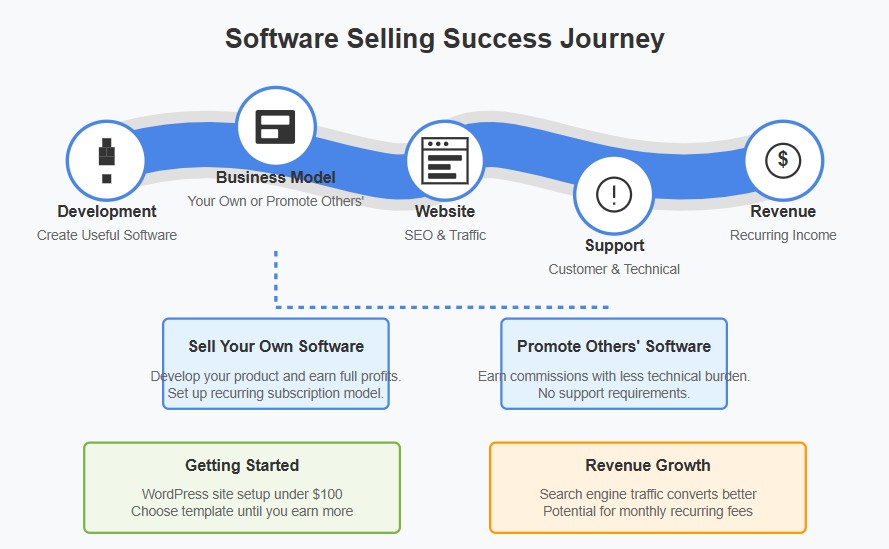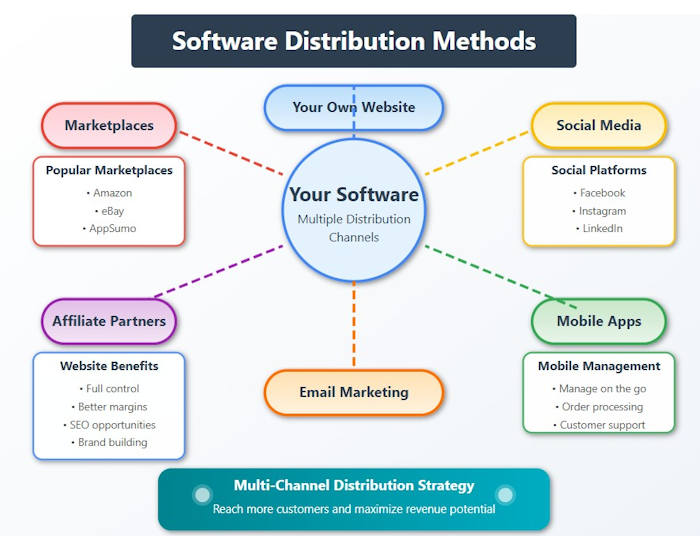In the ever-evolving landscape of ecommerce, the distribution of software has transitioned from a niche market to a profitable business model.
As global spending on software continues to rise, both new entrepreneurs and established businesses are capitalizing on online channels to sell their products. This article delves into effective strategies, common hurdles, and valuable insights for successfully selling software in the digital realm.
Understanding Your Market Position
To truly excel in the world of software distribution, it all starts with strategic market positioning. Before delving into sales techniques, it’s essential to grasp where your software fits within the vast landscape of options available.
Software offerings typically fall into distinct categories: enterprise solutions for large corporations, tools tailored for small businesses, applications designed for consumers, or utilities geared towards developers. Each category demands a unique approach and specific customer engagement tactics.
When I launched my first SaaS product in 2019, I initially tried to market it to a broad audience. However, this approach resulted in minimal traction despite the high quality of our software.
It wasn’t until I honed in on small accounting firms as our target audience that we saw a significant improvement in our messaging effectiveness and conversion rates soared. This experience taught me a valuable lesson: being specific in your market positioning is key to maximizing distribution efforts and achieving success.
Choosing the Right Distribution Channels
Software can be distributed through various online channels, each with distinct advantages:
- Direct Sales Through Your Website: Provides maximum control over the customer experience and eliminates commission fees. This approach works particularly well for established brands with existing traffic.
- Software Marketplaces: Platforms like AppSumo, G2, or industry-specific marketplaces offer built-in audiences but typically charge significant commissions (20-30% is common).
- App Stores: For mobile or platform-specific applications, app stores provide unmatched distribution but impose strict guidelines and take substantial revenue cuts.
- Affiliate Programs: Leveraging partners to promote your software can extend reach, though managing relationships requires consistent effort.
Many successful software companies employ multiple channels simultaneously, adjusting their approach based on performance metrics and market feedback.
Pricing Strategies That Drive Conversions
Pricing remains one of the most challenging aspects of digital software distribution. Common models include:
- One-time Purchase: Traditional perpetual licensing, increasingly rare in modern software distribution
- Subscription-based: Monthly or annual recurring payments, now the dominant model
- Freemium: Free basic version with premium upgrades, excellent for initial user acquisition
- Usage-based: Charging based on resource consumption or activity levels
- Tiered Pricing: Multiple package levels catering to different user needs
When transitioning our product from one-time purchases to a subscription model in 2021, we initially faced resistance from existing customers. However, by grandfathering existing users and clearly communicating the benefits of the new model, including more frequent updates and enhanced support. We managed to retain 89% of our customer base while improving long-term revenue predictability.
Building Trust With Potential Customers
Software purchases involve significant trust, particularly for business applications where reliability and security are paramount. Effective trust-building elements include:
- Comprehensive Documentation: Detailed guides demonstrate product maturity and commitment to user success
- Transparent Security Practices: Clear information about data handling and protection measures
- Social Proof: Customer testimonials, case studies, and reviews
- Free Trials or Demos: Low-risk opportunities to evaluate the product
- Responsive Support: Pre-sales questions answered quickly and thoroughly
When launching our enterprise security tool, we found that publishing a detailed white paper on our encryption methodology. While keeping the actual implementation proprietary, significantly increased conversion rates among technical decision-makers. This approach balanced transparency with intellectual property protection.
Optimizing the Purchase Process
The technical implementation of your sales funnel can dramatically impact conversion rates. Key considerations include:
- Payment Processing: Supporting multiple payment methods (credit cards, PayPal, regional payment systems)
- Geolocation Features: Currency conversion and localized pricing
- Account Creation: Balancing security with convenience
- License Management: Seamless activation and transparent license terms
- Cart Abandonment Recovery: Automated follow-up for incomplete purchases
Our research has shown that by streamlining the checkout process and providing the option for account creation rather than requiring it, online businesses can increase their conversion rates by a significant 26%. Additionally, implementing localized pricing strategies for key markets has proven to boost international sales by an impressive 34% over a six-month period.
Content Marketing for Software Distribution
Educational content serves as both a trust signal and an effective lead generation tool. Successful approaches include:
- Tutorial Content: Step-by-step guides solving common problems
- Comparison Articles: Honest evaluations against alternatives
- Industry Trend Analysis: Positioning your brand as a thought leader
- Case Studies: Detailed examples of customer success stories
- Video Demonstrations: Visual proof of functionality and benefits
One highly effective strategy we’ve implemented is the creation of in-depth guides that tackle related issues to those addressed by our software. For instance, our project management tool saw a significant boost in popularity following the release of a series on “Remote Team Productivity Frameworks.” These guides don’t overtly promote our product but instead showcase our expertise in the field.
Leveraging Analytics to Improve Performance
Data-driven optimization separates sustainable software businesses from those that struggle to scale. Critical metrics to monitor include:
- Conversion Rate: By traffic source, landing page, and user segment
- Customer Acquisition Cost (CAC): Total marketing and sales expenses divided by new customers
- Lifetime Value (LTV): Average revenue generated per customer
- Churn Rate: Percentage of customers who cancel subscriptions
- Feature Usage: Which capabilities drive retention and satisfaction
Our firsthand experience has shown that even small adjustments, like moving product screenshots above customer testimonials on landing pages, can lead to significant boosts in conversion rates.
These subtle changes may seem insignificant at first glance, but they have a tangible impact on the success of your online business. Without access to detailed analytics, these optimization opportunities would go unnoticed and untapped.
By leveraging comprehensive analytics tools, you can uncover valuable insights that will help you fine-tune your ecommerce strategy for maximum profitability.
It’s essential to continuously analyze and optimize every aspect of your online store to drive sales and increase revenue. Don’t overlook the power of data-driven decision-making when it comes to growing your online presence and maximizing profits.
In today’s competitive digital landscape, understanding how minor tweaks can make a major difference is crucial for staying ahead of the curve. By implementing strategic changes based on actionable data, you can unlock new growth opportunities and elevate your online selling game to new heights.
Managing Customer Relationships Post-Purchase
The sale is just the beginning of the customer relationship in software businesses. Effective post-purchase engagement includes:
- Onboarding Sequences: Guiding new users to initial success
- Knowledge Base: Self-service support resources
- Regular Updates: Demonstrating ongoing development
- Community Building: User forums or discussion groups
- Proactive Support: Identifying and resolving issues before customers report them
We discovered that clients who successfully completed our structured onboarding program saw a 67% increase in subscription renewal rates compared to those who opted out. This valuable insight prompted us to revamp our welcome sequence, making it more interactive and user-friendly.
Navigating Technical Challenges
Software distribution comes with unique technical considerations that impact success:
- Compatibility Requirements: Clearly communicating system requirements
- Installation Processes: Simplifying setup procedures
- Update Mechanisms: Seamless version upgrades
- Licensing Technology: Protecting intellectual property without frustrating legitimate users
- Integration Capabilities: Working with customers’ existing tools
When our enterprise customers encountered activation issues due to strict network policies, we introduced an offline activation method as a solution. This adaptability significantly boosted our success rate with larger organizations by addressing their specific implementation concerns.
International Expansion Considerations
Global software distribution introduces additional complexity:
- Language Localization: Translating not just the interface but marketing materials
- Payment Processing: Supporting region-specific payment methods
- Taxation: Navigating VAT, sales tax, and digital service taxes
- Legal Compliance: GDPR, CCPA, and other regulatory frameworks
- Cultural Adaptation: Adjusting marketing messages for different cultural contexts
Our initial expansion into European markets proved challenging until we implemented comprehensive VAT handling and made our documentation available in German and French. This investment increased European revenue by 215% in the following year.
When we first ventured into selling online to European customers, we faced obstacles that hindered our growth. However, after incorporating a robust VAT handling system and translating our documents into German and French, we saw a remarkable 215% increase in sales within the European market the next year.
Building Sustainable Competitive Advantage
Long-term success in software distribution requires developing defensible advantages:
- Continuous Innovation: Regular feature additions based on customer feedback
- Customer Success Focus: Ensuring users achieve their goals with your product
- Data Network Effects: Creating systems that become more valuable as usage increases
- Ecosystem Development: Building complementary tools or encouraging third-party integrations
- Brand Building: Creating emotional connections beyond functional benefits
The most successful software businesses combine multiple layers of competitive advantage, making customer switching increasingly costly over time.
Effective Marketing and Promotion
Beyond content marketing, software products benefit from targeted promotional activities:
- Search Engine Optimization: Ensuring your product appears for relevant queries
- Paid Advertising: Strategic campaigns on platforms frequented by your target audience
- Email Marketing: Nurturing leads and maintaining relationships with existing customers
- Product Hunt Launches: Generating initial momentum through tech-focused communities
- Webinars and Live Demonstrations: Interactive showcases of your software’s capabilities
In our experience promoting our data analytics tool, we have discovered that hosting subject-specific webinars tailored to address industry challenges has proven to be three times more effective in generating qualified leads compared to generic product demonstrations.
This approach not only attracts a targeted audience but also provides valuable insights into how businesses can leverage our software for profitable outcomes.
Customer Support as a Competitive Edge
In a crowded marketplace, exceptional support can differentiate your offering:
- Multiple Support Channels: Email, chat, phone, and community forums
- Clear Service Level Agreements: Setting appropriate expectations
- Knowledge Transfer: Converting support interactions into documentation
- Feedback Loops: Using support data to guide product development
- Technical Account Management: Dedicated resources for key accounts
Our implementation of a customer success program that included quarterly business reviews for enterprise clients resulted in a 38% increase in expansion revenue as we better understood their evolving needs.
Conclusion
The online distribution of software presents an incredible opportunity in today’s digital economy, offering a lucrative avenue for businesses to sell their products and services.
To capitalize on this potential, it is essential to adopt a strategic approach that combines technical expertise with effective marketing tactics.
By honing in on precise market positioning, optimizing distribution channels, implementing competitive pricing strategies, and nurturing strong customer relationships, software developers can establish sustainable and profitable ventures in the ecommerce landscape.
Successful online software businesses continuously refine their approach based on market feedback and performance data. As the ecommerce industry evolves, adaptability remains perhaps the most important quality for sustained growth.
Whether you’re launching your first product or scaling an established offering, the principles outlined in this article provide a foundation for effective digital software distribution in today’s competitive landscape.
Frequently Asked Questions
Q: Is it better to distribute software directly or through marketplaces? A: Depending on your specific circumstances, utilizing direct distribution can lead to higher margins and better control over customer relationships. On the other hand, marketplaces offer immediate access to established audiences. Many thriving software companies successfully employ both strategies simultaneously. Marketplaces act as valuable customer acquisition channels that ultimately drive traffic to direct platforms for upgrades and additional products.
Q: How do I determine the right pricing for my software? A: Conducting effective pricing research for your online business involves thorough competitive analysis, value-based calculations (consider how much money or time your software can save customers), and customer interviews to gauge their willingness to pay. It’s crucial to test different price points with select audiences before finalizing your strategy. The key factor is ensuring that your pricing aligns with the perceived value of your product while covering costs and supporting sustainable growth in the ecommerce market.
Q: What’s the most effective way to reduce churn in subscription-based software? A: To reduce churn in your online business, you need a comprehensive approach that begins with a solid onboarding process to ensure customers quickly see the value of your products or services. Consistent engagement through valuable content, proactive support, continuous enhancements based on usage data, and strategic check-ins at key points in the customer journey all play a role in boosting retention rates. The most effective strategies for retaining customers focus on helping them achieve their desired outcomes.
Q: How important is localization when distributing software internationally? A: Localization is key to expanding your online software business globally. While English-only software can be successful, translating marketing materials and documentation into different languages can significantly boost conversion rates in non-English-speaking markets. Before diving into full product translation, start by localizing your marketing efforts and documentation. Conduct market research to prioritize which languages to target first based on initial traction and potential profitability. In addition to language translation, consider cultural nuances when it comes to design preferences and feature priorities. Understanding these differences will help tailor your software offerings to better suit the needs of diverse international customers. By taking a strategic approach to localization, you can maximize the impact of your online business in various global markets.
Q: What protection methods work best for preventing software piracy without frustrating legitimate customers? A: The most effective approach balances reasonable protection with user convenience. Cloud-based activation systems, license keys tied to hardware identifiers, and subscription models with regular authentication checks provide protection while minimizing friction. However, excessive anti-piracy measures often harm legitimate users more than they deter determined pirates. Focus on adding continuous value that makes legitimate ownership worthwhile.




